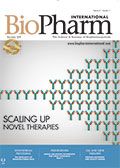Single-Use Mixing Technology for Virus Clearance (Part 2: Compatibility, Leachables, and Scale-Up Studies)
The second half of this article describes the testing methods used by the authors to demonstrate the applicability of single-use mixing technology for virus inactivation.
Nick psdesign1/Stock.Adobe.com

The potency of recombinant proteins such as monoclonal antibodies remains typically unaffected by detergent-based virus inactivation treatments because detergents tend to target lipids and lipid derivatives rather than proteins. Virus inactivation treatments that use detergents are robust with respect to temperature, which allows these steps to be performed at room temperature without thermoregulation. In this two-part article, the authors describe the testing performed to demonstrate the applicability of single-use mixing technology for a virus inactivation step performed using detergent.
Click
herefor a PDF of the article.
Peer-Reviewed
Submitted: Nov. 7, 2017
Accepted: April 18, 2018
About the authors
Ronan McCarthy is seniordownstream process scientist, François Coutard was bioengineering unit manager, and Eve DePauw and Ludovic Bouchez are downstream process technicians; all at the bioengineering unit at LFB Biomanufacturing. Nick Hutchinson was technical content marketing manager, Isabelle Uettwiller is head of validation lab, confidence validation service, and Amélie Boulais is process development consultant, integrated solutions marketing, all at Sartorius Stedim Biotech.
Article Details
BioPharm International
Vol. 31, Number 11
November 2018
Pages: 23–28, 44
Citation
When referring to this article, please cite as R. McCarthy, et al., “Single-Use Mixing Technology for Virus Clearance (Part 2: Compatibility, Leachables, and Scale-Up Studies),” BioPharm International 31 (11) 2018.

Thermo Fisher Opens Advanced Therapies Collaboration Center in California
April 18th 2025The 6000-square-foot facility will provide cell therapy developers the support they need to transition to CGMP manufacturing, and an expanded footprint of the new center is expected to open in Philadelphia later in 2025.